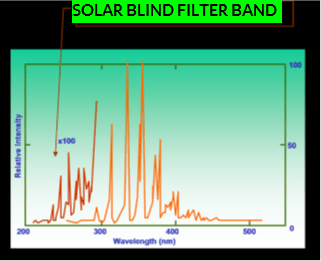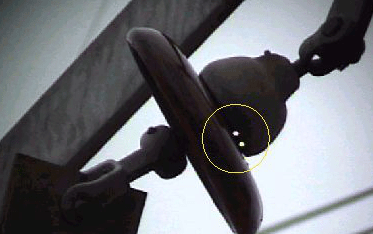The corona effect detection is being used as a diagnostic tool to control critical components in an electrical network. By using a highly sensitive ultraviolet radiation camera such as Amperis CoroCAM, corona and ultraviolet radiation can be recorded to evaluate the state of a device. Failures in high voltage equipment carry a very high risk so preventive maintenance saves high costs. Partial discharges may also occur due to structural defects or problems in the insulation.
When partial discharge and corona phenomena occur, large amounts of ultraviolet radiation are triggered, indicating the conditions of the isolation of the operating equipment and the detection of defects. The optical method is clearly the most suitable diagnostic method of discharge and the one that offers the greatest sensitivity and resolution in all conditions.
By using a highly sensitive ultraviolet radiation receiver, corona and ultraviolet radiation can be recorded to evaluate the state of the equipment through the processing and analysis of the data obtained.

Fig. 1: High voltage line – partial discharge. Fig. 2: Discharge caused by an insulator crack
The principle of corona discharge detection using an ultraviolet image camera
When an ionization discharge occurs in a high-voltage equipment, a corona, flutter or arc can occur due to the difference in the electric field strength. During this process of electron ionization (discharge), energy is released, light, sound, ozone, ultraviolet, etc. are emitted. With UV imaging technology, these ultraviolet signals produced during the discharge process are detected. Through this technology, the location and intensity of the corona can be detected after the processing of data, images and overlays with visible light images.
Among all the frequencies of light emitted, UV waves have proven to be the only efficient way for this type of tests. The UV wavelength range is usually 40-400 nm. The wavelength of the solar ultraviolet that reaches the surface of the Earth is more than 300 nm. (due to the Earth's ozone layer, which absorbs a part of the long wave ultraviolet).
Ultraviolet light waves less than 280 nm are in the solar blind area. If it can be detected, then it can only be from the Earth's radiation.

Figure 3. Light emission from the corona discharge. It must be taken into account that most of the light emitted is in the UV
The principle of our CoroCAM cameras is to use the solar blind interval thanks to the application of special filters, so that the instrument can work between the wavelength of 240 to 280 nm of ultraviolet during the day (solar blind UV band), of so that even during the day the corona effect can be observed. Some of the ultraviolet image cameras can only be used at a certain time of the day or night due to the interference of the sun coming from the ultraviolet rays.
The corona effect in a high voltage equipment in the initial stage of discharge is not continuous, but fleeting. CoroCAM ultraviolet image cameras allow the observation of the corona with two modes: real time monitoring and integrated mode, which shows and retains the amount of ultraviolet photons in a certain time and area (the region can be adjusted) on the screen, and it is updated in real time.
That is, the corona is a light effect triggered by high localized electric fields that exceed a certain critical value that ionizes the air and produces the discharge, under normal atmospheric conditions, this critical value is between 20-30 kV / cm
During the PD process, the nitrogen molecules in the air are excited and emit ultraviolet radiation, generally in the wavelength range of 200-405 nm.
The main factors that affect UV detection
With the corona effect camera the number of photons is observed and this parameter is used as intensity index in the observed object of the corona. Many factors have a direct effect and affect the photon count as: the detection distance, humidity of the atmosphere, ambient temperature, pressure, altitude and gain setting of the instrument:
- Detection distance: The detection distance has an outstanding effect on the results, that is, the greater the detection distance, the smaller the field of vision and the less sensitive.
- Humidity and contamination: Humidity plays an important role and you must find a way to solve this problem to allow analysis. As the humidity increases, the conductivity of the insulator surface is improved, which favors the discharge. The more atmospheric moisture absorbs more ultraviolet light so that the detection of ultraviolet radiation is reduced.

Fig. 4: An insulating steel cover. Fig. 5: Discharge caused by a loose connection
- Effects of air pressure and temperature: If the pressure increases or the temperature decreases, the intensity of the electric field of the corona increases, since the density of the air increases, so that the average distance between the air molecules increases and the free path of the electrons decreases and the air It is more difficult to ionize, increasing the intensity of the electric field of the corona.
- Effects of altitude: When the elevation increases, the pressure decreases, so the voltage that causes the initial corona decreases. That is, at a higher altitude, less crown effect.
- The influence of detector gain: The gain of the camera is regulated, so that the instrument can be sensitive to the coron, while the influence of background interference can be reduced.
Characteristics of the inspection by corona effect
The UV inspection is designed to detect external phenomena on the surface of the equipment.
As we have seen before, humidity hurts the measurement, but inspections can be done under practically any climatic condition (not including rain). These inspections allow the detection of potential problems in their early stages, before they have progressed to the point of serious damage and the corresponding need for rapid replacement of the affected component. Being related to voltage instead of current, corona discharge has an intermittent periodic appearance that corresponds to the sinusoidal pattern of the line.
Corrosion and erosion due to ozone and nitrogen oxides created by the corona are processes that coexist with corona discharge. So corrosion occurs in the porcelain insulator (in the figure below you can see the 2 separations formed).

Corona effect: environmental and safety concern
As mentioned, the partial discharge, as it is a source of audio noise (AN) or radio or TV interference (RI or TVI), so it must be removed even if it does not have an immediate effect on the reliability of the line. The first thing to do is locate exactly the PD source looking for the crown. With the use of Amperis CoroCAM crown efcto camera range, in a few minutes the discharge sources are perfectly located and identified.
Corona active degradation agent
Amperis CoroCAM can detect corona-like activities in polymer insulators. These non-ceramic insulators are susceptible to degradation by the corona effect, since the nitric acid formed by the nitrogen oxide generated and the water vapors damage the polymer shell. In addition, a crack or puncture in the polymer housing will allow moisture to penetrate the fiberglass rod. The combination of moisture and acidic material degrades the fiberglass rod producing even fracture.
Porcelain insulators also suffer the effects of PD. In these cases the corona effect chamber indicates short or internal arcs, cracked or eroded cement, rusty joint, etc.
Corona as an indicator
As we have explained, the corona effect is an indicator of defective designs and installations, as well as deficient material. The appearance of a corona indicates processes of degradation in process and helps us as an alert. One of the applications for corona inspection is in the start-up phase of any new electrical installation. The CorCAM is a tool to allow the operator of the power system to verify that the installation was carried out correctly. Using the corona effect cameras during start-up results in less maintenance effort.
Conclusion
A corona effect camera that generates UV images plays an important role in the detection of defects in high and medium voltage electrical constructions. This way we detect and identify the real location of the download through the high resolution of the CoroCAM.
The corona cameras for the detection of Amperis, use the ultraviolet image that is a relatively new technology, but it is easy to use, efficient, intuitive and the monitoring in vivo facilitates the detection and the maintenance. These cameras provide an immediate response in processes with problems that would go undetected and without assistance. The UV inspection in distribution overhead lines and substations provides us with information on the conditions in which the line is located (early detection of faults) and on the quality of the design and of the workforce during the installation phase.
There are many more applications in the energy industry that can be exploited with this technology. Corona discharge detection is only one of them.